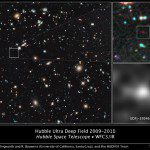Astronomers have pushed NASA’s Hubble Space Telescope to its limits by finding what is likely to be the most distant object ever seen in the universe. The object’s light traveled 13.2 billion years to reach Hubble, roughly 150 million years longer than the previous record holder. The age of the universe is approximately 13.7 billion years.

The tiny, dim object is a compact galaxy of blue stars that existed 480 million years after the big bang. More than 100 such mini-galaxies would be needed to make up our Milky Way. The new research offers surprising evidence that the rate of star birth in the early universe grew dramatically, increasing by about a factor of 10 from 480 million years to 650 million years after the big bang.
“NASA continues to reach for new heights, and this latest Hubble discovery will deepen our understanding of the universe and benefit generations to come,” said NASA Administrator Charles Bolden, who was the pilot of the space shuttle mission that carried Hubble to orbit. “We could only dream when we launched Hubble more than 20 years ago that it would have the ability to make these types of groundbreaking discoveries and rewrite textbooks.”
Astronomers don’t know exactly when the first stars appeared in the universe, but every step farther from Earth takes them deeper into the early formative years when stars and galaxies began to emerge in the aftermath of the big bang.
The object appears as a faint dot of starlight in the Hubble exposures. It is too young and too small to have the familiar spiral shape that is characteristic of galaxies in the local universe. Although its individual stars can’t be resolved by Hubble, the evidence suggests this is a compact galaxy of hot stars formed more than 100-to-200 million years earlier from gas trapped in a pocket of dark matter.


